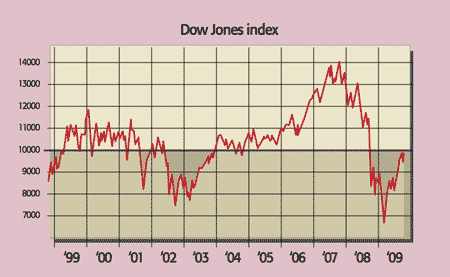"No other index has captured the imagination of the public to the same degree" as America's Dow Jones, says Ravi Nagarajan on Seekingalpha.com. Dating from the 1890s, it is the oldest index in the world's leading stockmarket.
Throw in people's fascination with round numbers, and it's no wonder bulls were excited by the Dow's close above 10,000 last week. But it's hardly the first time. It first hit 10,000 in March 1999 and has lost 23% since then in real terms, says John Authers in the FT.
And investors should note that the index is a narrow and "highly misleading" gauge of US market performance because it is calculated in an "antiquated way", says Nagarajan.
MoneyWeek
Subscribe to MoneyWeek today and get your first six magazine issues absolutely FREE

Sign up to Money Morning
Don't miss the latest investment and personal finances news, market analysis, plus money-saving tips with our free twice-daily newsletter
Don't miss the latest investment and personal finances news, market analysis, plus money-saving tips with our free twice-daily newsletter
It contains just 30 stocks chosen by a committee, and rather than being weighted by market capitalisation (the number of shares in issue multiplied by the share price), as most indices now are, it is weighted by share price. So a firm with shares worth $100 has far more impact on the Dow than one whose shares trade at $10.

This makes little sense. In February five major firms in the Dow, including General Electric and Citigroup, were trading at under $10 a share. Had they become worthless, the Dow would have fallen by just 200 points vastly understating the actual impact of such an event, says Nagarajan.
At present, notes Authers, IBM comprises 9% of the index. Meanwhile ExxonMobil, which is six times bigger than IBM in terms of market capitalisation, has a lower weighting thanks to its lower share price.
So the US index to watch is the S&P 500 where "the rally continues to move further away from the fundamentals", says David Rosenberg of Gluskin Sheff. Banks worried about further losses aren't lending.
And with loan losses unlikely to peak until well into next year, the credit squeeze will endure, says The Economist. Consumers, with debts worth 129% of disposable income, have only just started retrenching given unemployment is still on the rise.
Even in mid-September the S&P's p/e ratio (taking a ten-year average of earnings) was 35% above the long-term average. For now, easy money and government spending are giving markets momentum, but investors won't be able to ignore the poor backdrop forever.
Get the latest financial news, insights and expert analysis from our award-winning MoneyWeek team, to help you understand what really matters when it comes to your finances.
MoneyWeek is written by a team of experienced and award-winning journalists, plus expert columnists. As well as daily digital news and features, MoneyWeek also publishes a weekly magazine, covering investing and personal finance. From share tips, pensions, gold to practical investment tips - we provide a round-up to help you make money and keep it.
-
 What are my retirement income options?
What are my retirement income options?We’re all told to save into a pension, but there’s widespread confusion about how to take an income from our savings and investments at retirement, a new study has found. We look at your retirement income options.
-
 UK interest rates: will the Bank of England lower rates?
UK interest rates: will the Bank of England lower rates?The Bank of England’s Monetary Policy Committee’s (MPC) final interest rates meeting of the year takes place tomorrow (18 December) and most experts expect a cut

